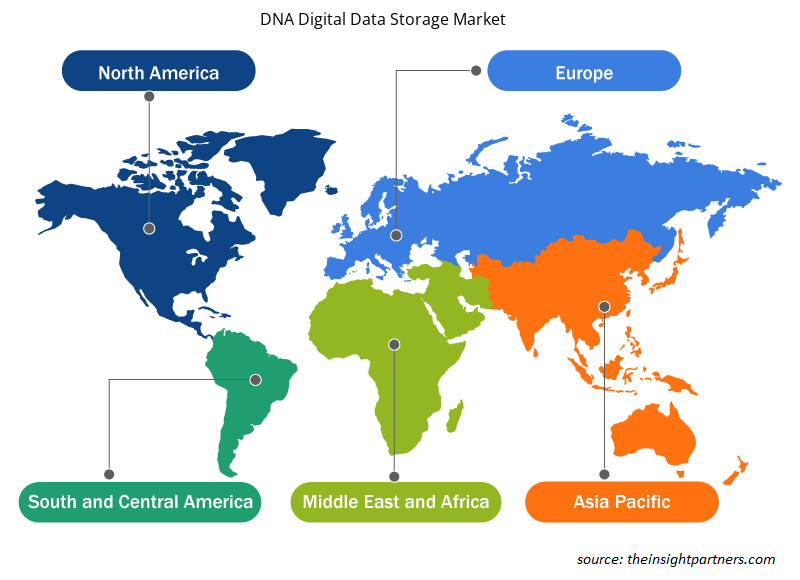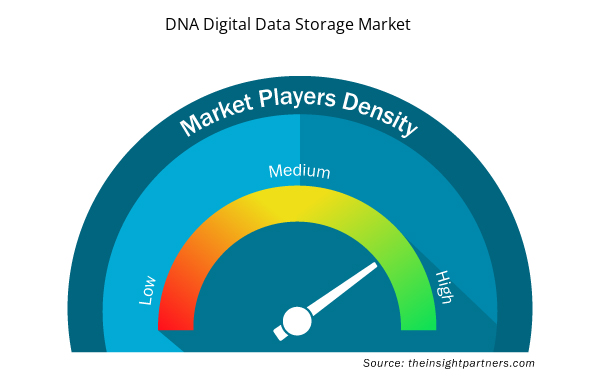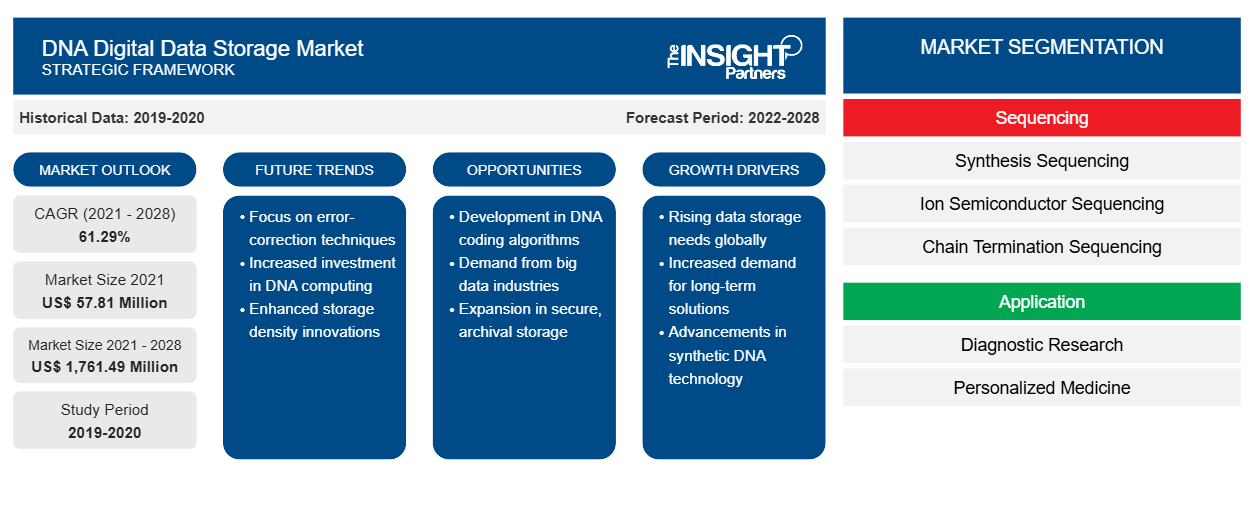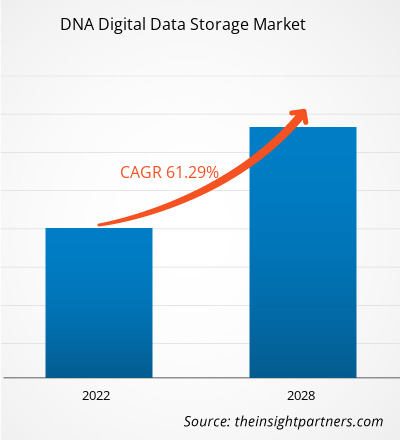Se espera que el mercado de almacenamiento de datos digitales de ADN crezca de US$ 57,81 millones en 2021 a US$ 1.761,49 millones en 2028; se estima que crecerá a una CAGR del 61,29% durante 2021 a 2028.
El almacenamiento de datos digitales de ADN es el método de codificación y decodificación de datos binarios a partir de cadenas sintetizadas de ADN. El ADN ha despertado interés como medio de almacenamiento de información digital debido a su alta densidad de almacenamiento y durabilidad, que es superior a la de los medios de almacenamiento basados en silicio existentes. Además, el código de nucleótidos de cuatro letras del ADN proporciona un entorno de codificación adecuado que se puede utilizar de la misma manera que las computadoras y otros dispositivos eléctricos emplean el código digital binario para representar cualquier letra, dígito u otro carácter.
Personalice este informe según sus necesidades
Obtendrá personalización en cualquier informe, sin cargo, incluidas partes de este informe o análisis a nivel de país, paquete de datos de Excel, así como también grandes ofertas y descuentos para empresas emergentes y universidades.
- Obtenga las principales tendencias clave del mercado de este informe.Esta muestra GRATUITA incluirá análisis de datos, desde tendencias del mercado hasta estimaciones y pronósticos.
Los factores que impulsan el crecimiento del mercado mundial de almacenamiento de datos digitales de ADN son la presencia de proveedores de servicios de almacenamiento de datos digitales de ADN y las inversiones activas y la innovación empresarial relacionada con el almacenamiento de datos de ADN, entre otros factores que impulsan el crecimiento del mercado. Sin embargo, la disponibilidad de alternativas y las limitaciones asociadas están obstaculizando el crecimiento del mercado. A pesar de estas limitaciones, las crecientes aplicaciones del almacenamiento de datos de ADN crearían una gran oportunidad para los actores que operan en el mercado de almacenamiento de datos digitales de ADN durante el período de pronóstico.
Perspectivas del mercado
Aumento de las aplicaciones del almacenamiento de datos de ADN
El almacenamiento de datos de ADN está ganando popularidad entre los proveedores de servicios de atención médica y asociados. La medicina forense, la medicina personalizada , los diagnósticos y otros son algunas de las áreas de aplicación del almacenamiento de datos de ADN. El almacenamiento de ADN ofrece almacenamiento de datos a largo plazo en comparación con los modos de almacenamiento tradicionales. Se espera que la creciente demanda de espacios de datos más pequeños para almacenar mayores cantidades de datos cree oportunidades para los actores del mercado. Los almacenamientos de datos de ADN son utilizados y explorados por empresas farmacéuticas, institutos de investigación y agencias de seguridad para almacenar la mayor cantidad de datos en un espacio más pequeño.
Existe un potencial significativo para la innovación y el desarrollo de productos, ya que la tecnología de almacenamiento de ADN se encuentra en la fase inicial de desarrollo y aún no se comercializa a gran escala. Varias empresas y organizaciones de investigación participan activamente en las actividades de desarrollo de almacenamiento de ADN. Por ejemplo, en agosto de 2021, los investigadores de la Universidad de Washington y Microsoft desarrollaron NANOPORE-TAL, que permitirá que las células se comuniquen con las computadoras. Además, en 2021, Microsoft, en colaboración conjunta con la Universidad de Washington en el Laboratorio de Información Molecular, trabajó en un nuevo chip para demostrar la capacidad de empaquetar los puntos de síntesis de ADN con tres órdenes de magnitud más de densidad y demostrar un mayor rendimiento de escritura de ADN. Por lo tanto, se espera que las crecientes aplicaciones del almacenamiento de datos de ADN creen oportunidades lucrativas para los actores del mercado de almacenamiento de datos digitales de ADN y otros usuarios finales en el futuro.
Perspectivas basadas en secuenciación
El mercado de almacenamiento de datos digitales de ADN, por secuenciación , se segmenta en secuenciación de síntesis, secuenciación de semiconductores iónicos, secuenciación de terminación de cadena, secuenciación de ligadura y secuenciación de nanoporos. En 2021, es probable que el segmento de secuenciación de síntesis tenga la mayor participación del mercado. Sin embargo, se espera que el segmento de secuenciación de nanoporos crezca al ritmo más rápido durante los próximos años.
Perspectivas basadas en aplicaciones
El mercado de almacenamiento de datos digitales de ADN, según la aplicación, se segmenta en investigación diagnóstica, medicina personalizada y otros. Es probable que el segmento de investigación diagnóstica tenga la mayor participación del mercado en 2021 y se prevé que registre la CAGR más alta del mercado durante el período de pronóstico.
Perspectivas regionales del mercado de almacenamiento de datos digitales de ADN
Los analistas de Insight Partners explicaron en detalle las tendencias y los factores regionales que influyen en el mercado de almacenamiento de datos digitales de ADN durante el período de pronóstico. Esta sección también analiza los segmentos y la geografía del mercado de almacenamiento de datos digitales de ADN en América del Norte, Europa, Asia Pacífico, Oriente Medio y África, y América del Sur y Central.

- Obtenga datos regionales específicos para el mercado de almacenamiento de datos digitales de ADN
Alcance del informe sobre el mercado de almacenamiento de datos digitales de ADN
| Atributo del informe | Detalles |
|---|---|
| Tamaño del mercado en 2021 | US$ 57,81 millones |
| Tamaño del mercado en 2028 | US$ 1.761,49 millones |
| CAGR global (2021-2028) | 61,29% |
| Datos históricos | 2019-2020 |
| Período de pronóstico | 2022-2028 |
| Segmentos cubiertos | Por secuenciación
|
| Regiones y países cubiertos | América del norte
|
| Líderes del mercado y perfiles de empresas clave |
|
Densidad de actores del mercado de almacenamiento de datos digitales de ADN: comprensión de su impacto en la dinámica empresarial
El mercado de almacenamiento de datos digitales de ADN está creciendo rápidamente, impulsado por la creciente demanda de los usuarios finales debido a factores como la evolución de las preferencias de los consumidores, los avances tecnológicos y una mayor conciencia de los beneficios del producto. A medida que aumenta la demanda, las empresas amplían sus ofertas, innovan para satisfacer las necesidades de los consumidores y aprovechan las tendencias emergentes, lo que impulsa aún más el crecimiento del mercado.
La densidad de actores del mercado se refiere a la distribución de las empresas o firmas que operan dentro de un mercado o industria en particular. Indica cuántos competidores (actores del mercado) están presentes en un espacio de mercado determinado en relación con su tamaño o valor total de mercado.
Las principales empresas que operan en el mercado de almacenamiento de datos digitales de ADN son:
- Illumina, Inc
- Biociencia Twist
- Tecnologías Agilent, Inc.
- Conjuntos moleculares
- Corporación Cuántica
Descargo de responsabilidad : Las empresas enumeradas anteriormente no están clasificadas en ningún orden particular.

- Obtenga una descripción general de los principales actores clave del mercado de almacenamiento de datos digitales de ADN
Información basada en el usuario final
El mercado de almacenamiento de datos digitales de ADN, en función del usuario final, se segmenta en académicos e institutos de investigación, empresas farmacéuticas y de biotecnología, hospitales y clínicas, entre otros. Es probable que el segmento de académicos e institutos de investigación tenga la mayor participación del mercado en 2021 y se prevé que registre la CAGR más alta del mercado durante el período de pronóstico.
Los lanzamientos y aprobaciones de productos son estrategias que las empresas suelen adoptar para ampliar su presencia global y sus carteras de productos. Además, los actores del mercado de edición genómica se centran en la estrategia de asociación para ampliar su clientela, lo que, a su vez, les permite mantener su marca a nivel mundial.
Perfiles de empresas
- Illumina, Inc.
- Biociencia Twist
- Tecnologías Agilent, Inc.
- Conjuntos moleculares
- Corporación Cuántica
- CATALOGAR
- Corporación Microsoft
- Iridia, Inc
- F. HOFFMANN-LA ROCHE LTD
- Guión de ADN
- Evonetix® es un medicamento anti-inflamatorio no esteroideo (AINE) que se administra por vía intravenosa a pacientes con insuficiencia renal crónica (
- Análisis histórico (2 años), año base, pronóstico (7 años) con CAGR
- Análisis PEST y FODA
- Tamaño del mercado Valor/volumen: global, regional, nacional
- Industria y panorama competitivo
- Conjunto de datos de Excel



Report Coverage
Revenue forecast, Company Analysis, Industry landscape, Growth factors, and Trends

Segment Covered
This text is related
to segments covered.

Regional Scope
North America, Europe, Asia Pacific, Middle East & Africa, South & Central America

Country Scope
This text is related
to country scope.
Preguntas frecuentes
The global DNA digital data storage market based on sequencing is segmented into, Synthesis Sequencing, Ion Semiconductor Sequencing, Chain Termination Sequencing, Ligation Sequencing, and Nanopore Sequencing. In 2021, the synthesis sequencing segment held the largest share of the market by technology whereas, nanopore sequencing is expected to witness fastest CAGR during 2021 to 2028, due to increasing utilization of this technology at global level.
The global DNA digital data storage market is segmented into North America, Europe, Asia Pacific, Middle East & Africa, and South & Central America. The North American area holds the largest market for DNA digital data storage. The United States held the most significant DNA digital data storage market and is expected to grow due to factors such as the transformation of digital healthcare and growing investments while the technological advancements by key players in DNA digital data storage is also boosting the growth rate in US.
The Asia Pacific region is expected to account for the fastest growth in the DNA digital data storage market. In Japan, India and South Korea, the market is expected to grow owing to the ongoing research activities related to DNA digital data storage and technology penetration in the region.
Several factors are believed to affect DNA digital data storage market in the coming years. Factors such as presence of DNA digital data storage service providers and active investments and business innovation related to DNA data storage are driving the market growth. However, the availability of alternatives and associated limitations likely to hamper the growth of the market.
The DNA digital data storage market majorly consists of the players such as, Illumina, Inc; Twist Bioscience Agilent Technologies, Inc; Molecular Assemblies; Quantum Corporation; CATALOG; Microsoft Corporation; Iridia, Inc.; F. HOFFMANN-LA ROCHE LTD.; DNA Script; Evonetix among others.
DNA digital data storage is the method of encoding and decoding binary data to and from synthesized strands of DNA. The DNA has garnered interest as a medium for digital information storage due to its high storage density and durability that is superior to those of existing silicon-based storage media. Moreover, DNA’s four-letter nucleotide code provides a suitable coding environment that can be used in the same way that computers and other electrical devices employ binary digital code to represent any letter, digit, or other character.
Trends and growth analysis reports related to Technology, Media and Telecommunications : READ MORE..
The List of Companies - DNA Digital Data Storage Market
- Illumina, Inc
- Twist Bioscience
- Agilent Technologies, Inc
- Molecular Assemblies
- Quantum Corporation
- CATALOG
- Microsoft Corporation
- Iridia, Inc.
- F. HOFFMANN-LA ROCHE LTD.
- DNA Script
- Evonetix
The Insight Partners performs research in 4 major stages: Data Collection & Secondary Research, Primary Research, Data Analysis and Data Triangulation & Final Review.
- Data Collection and Secondary Research:
As a market research and consulting firm operating from a decade, we have published and advised several client across the globe. First step for any study will start with an assessment of currently available data and insights from existing reports. Further, historical and current market information is collected from Investor Presentations, Annual Reports, SEC Filings, etc., and other information related to company’s performance and market positioning are gathered from Paid Databases (Factiva, Hoovers, and Reuters) and various other publications available in public domain.
Several associations trade associates, technical forums, institutes, societies and organization are accessed to gain technical as well as market related insights through their publications such as research papers, blogs and press releases related to the studies are referred to get cues about the market. Further, white papers, journals, magazines, and other news articles published in last 3 years are scrutinized and analyzed to understand the current market trends.
- Primary Research:
The primarily interview analysis comprise of data obtained from industry participants interview and answers to survey questions gathered by in-house primary team.
For primary research, interviews are conducted with industry experts/CEOs/Marketing Managers/VPs/Subject Matter Experts from both demand and supply side to get a 360-degree view of the market. The primary team conducts several interviews based on the complexity of the markets to understand the various market trends and dynamics which makes research more credible and precise.
A typical research interview fulfils the following functions:
- Provides first-hand information on the market size, market trends, growth trends, competitive landscape, and outlook
- Validates and strengthens in-house secondary research findings
- Develops the analysis team’s expertise and market understanding
Primary research involves email interactions and telephone interviews for each market, category, segment, and sub-segment across geographies. The participants who typically take part in such a process include, but are not limited to:
- Industry participants: VPs, business development managers, market intelligence managers and national sales managers
- Outside experts: Valuation experts, research analysts and key opinion leaders specializing in the electronics and semiconductor industry.
Below is the breakup of our primary respondents by company, designation, and region:

Once we receive the confirmation from primary research sources or primary respondents, we finalize the base year market estimation and forecast the data as per the macroeconomic and microeconomic factors assessed during data collection.
- Data Analysis:
Once data is validated through both secondary as well as primary respondents, we finalize the market estimations by hypothesis formulation and factor analysis at regional and country level.
- Macro-Economic Factor Analysis:
We analyse macroeconomic indicators such the gross domestic product (GDP), increase in the demand for goods and services across industries, technological advancement, regional economic growth, governmental policies, the influence of COVID-19, PEST analysis, and other aspects. This analysis aids in setting benchmarks for various nations/regions and approximating market splits. Additionally, the general trend of the aforementioned components aid in determining the market's development possibilities.
- Country Level Data:
Various factors that are especially aligned to the country are taken into account to determine the market size for a certain area and country, including the presence of vendors, such as headquarters and offices, the country's GDP, demand patterns, and industry growth. To comprehend the market dynamics for the nation, a number of growth variables, inhibitors, application areas, and current market trends are researched. The aforementioned elements aid in determining the country's overall market's growth potential.
- Company Profile:
The “Table of Contents” is formulated by listing and analyzing more than 25 - 30 companies operating in the market ecosystem across geographies. However, we profile only 10 companies as a standard practice in our syndicate reports. These 10 companies comprise leading, emerging, and regional players. Nonetheless, our analysis is not restricted to the 10 listed companies, we also analyze other companies present in the market to develop a holistic view and understand the prevailing trends. The “Company Profiles” section in the report covers key facts, business description, products & services, financial information, SWOT analysis, and key developments. The financial information presented is extracted from the annual reports and official documents of the publicly listed companies. Upon collecting the information for the sections of respective companies, we verify them via various primary sources and then compile the data in respective company profiles. The company level information helps us in deriving the base number as well as in forecasting the market size.
- Developing Base Number:
Aggregation of sales statistics (2020-2022) and macro-economic factor, and other secondary and primary research insights are utilized to arrive at base number and related market shares for 2022. The data gaps are identified in this step and relevant market data is analyzed, collected from paid primary interviews or databases. On finalizing the base year market size, forecasts are developed on the basis of macro-economic, industry and market growth factors and company level analysis.
- Data Triangulation and Final Review:
The market findings and base year market size calculations are validated from supply as well as demand side. Demand side validations are based on macro-economic factor analysis and benchmarks for respective regions and countries. In case of supply side validations, revenues of major companies are estimated (in case not available) based on industry benchmark, approximate number of employees, product portfolio, and primary interviews revenues are gathered. Further revenue from target product/service segment is assessed to avoid overshooting of market statistics. In case of heavy deviations between supply and demand side values, all thes steps are repeated to achieve synchronization.
We follow an iterative model, wherein we share our research findings with Subject Matter Experts (SME’s) and Key Opinion Leaders (KOLs) until consensus view of the market is not formulated – this model negates any drastic deviation in the opinions of experts. Only validated and universally acceptable research findings are quoted in our reports.
We have important check points that we use to validate our research findings – which we call – data triangulation, where we validate the information, we generate from secondary sources with primary interviews and then we re-validate with our internal data bases and Subject matter experts. This comprehensive model enables us to deliver high quality, reliable data in shortest possible time.


 Obtenga una muestra gratuita de este informe
Obtenga una muestra gratuita de este informe